-
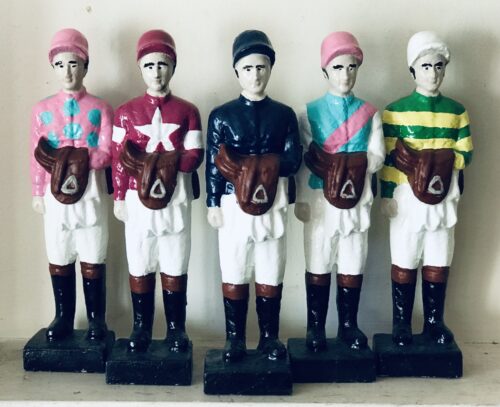
 Unique and unusual cast-iron Jockey Figurine in Gigginstown colours.This charming little gentleman stands 38cm tall and is approx 10cm wide at his plinth.They weigh a surprising 6kg.These limited edition figurines were part of a collection which stood pride of place at a well known public house in Co Kerry.Also available in colours such as Rich Ricci,Gigginstown,Coolmore,JP McManus.These figurines will make a stunning addition to any home bar or pub. 38cm x 10cm 6kg
Unique and unusual cast-iron Jockey Figurine in Gigginstown colours.This charming little gentleman stands 38cm tall and is approx 10cm wide at his plinth.They weigh a surprising 6kg.These limited edition figurines were part of a collection which stood pride of place at a well known public house in Co Kerry.Also available in colours such as Rich Ricci,Gigginstown,Coolmore,JP McManus.These figurines will make a stunning addition to any home bar or pub. 38cm x 10cm 6kg -

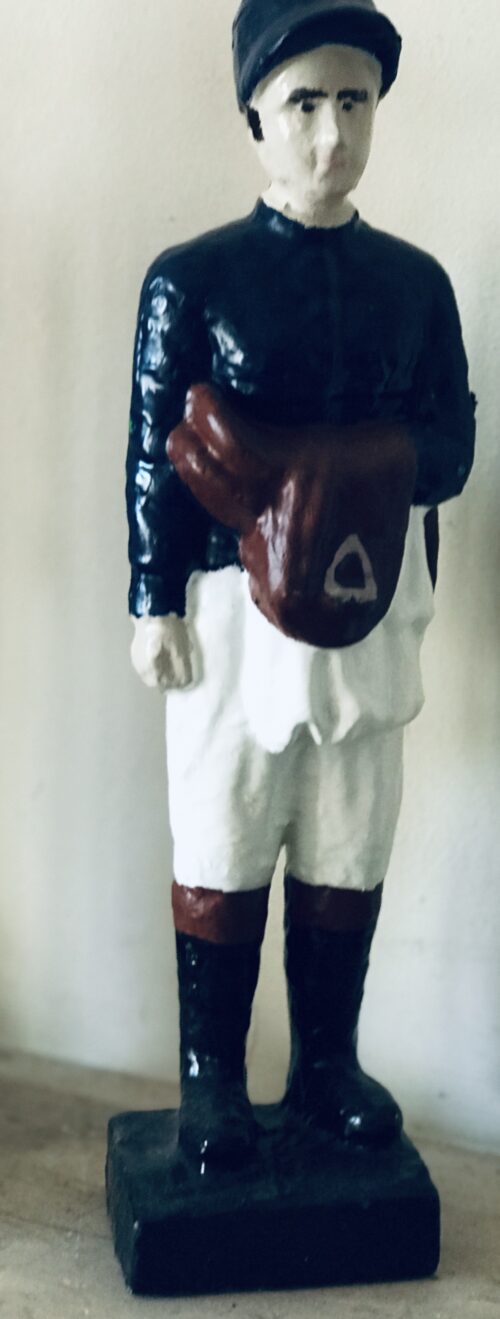 Unique and unusual cast-iron Jockey Figurine in the legendary Coolmore colours (Mrs John Magnier.This charming little gentleman stands 38cm tall and is approx 10cm wide at his plinth.They weigh a surprising 6kg.These limited edition figurines were part of a collection which stood pride of place at a well known public house in Co Kerry.Also available in colours such as Rich Ricci,Gigginstown,Coolmore,JP McManus.These figurines will make a stunning addition to any home bar or pub. 38cm x 10cm 6kg
Unique and unusual cast-iron Jockey Figurine in the legendary Coolmore colours (Mrs John Magnier.This charming little gentleman stands 38cm tall and is approx 10cm wide at his plinth.They weigh a surprising 6kg.These limited edition figurines were part of a collection which stood pride of place at a well known public house in Co Kerry.Also available in colours such as Rich Ricci,Gigginstown,Coolmore,JP McManus.These figurines will make a stunning addition to any home bar or pub. 38cm x 10cm 6kg -
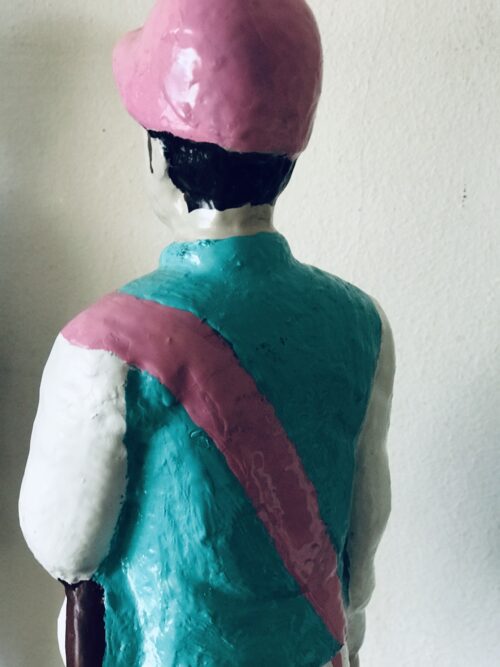
 Unique and unusual cast-iron Jockey Figurine in the legendary Frankel colours (Khalid Abdulla-Juddmonte ).This charming little gentleman stands 38cm tall and is approx 10cm wide at his plinth.They weigh a surprising kg.These limited edition figurines were part of a collection which stood pride of place at a well known public house in Co Kerry.Also available in colours such as Rich Ricci,Gigginstown,Coolmore,JP McManus.These figurines will make a stunning addition to any home bar or pub. 38cm x 10cm 5kg
Unique and unusual cast-iron Jockey Figurine in the legendary Frankel colours (Khalid Abdulla-Juddmonte ).This charming little gentleman stands 38cm tall and is approx 10cm wide at his plinth.They weigh a surprising kg.These limited edition figurines were part of a collection which stood pride of place at a well known public house in Co Kerry.Also available in colours such as Rich Ricci,Gigginstown,Coolmore,JP McManus.These figurines will make a stunning addition to any home bar or pub. 38cm x 10cm 5kg -

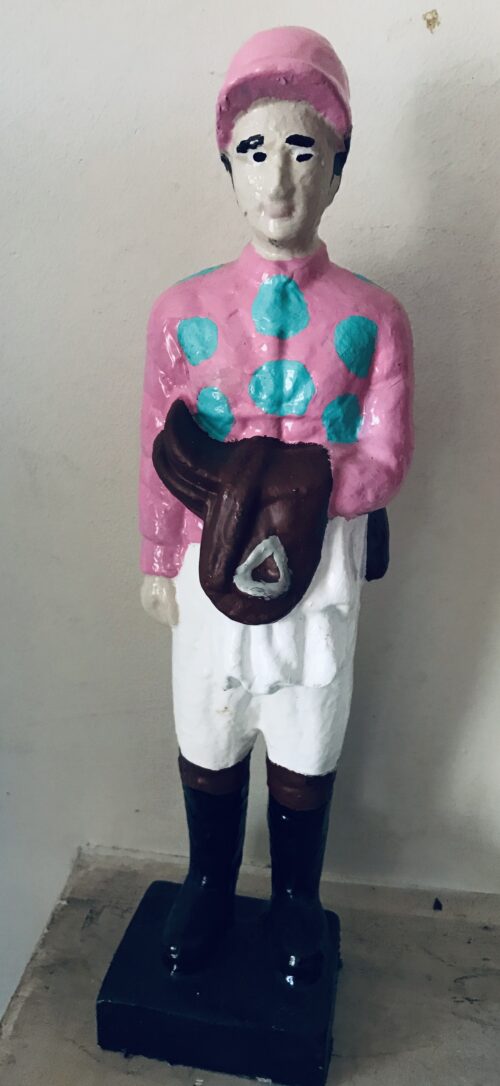 Unique and unusual cast-iron Jockey Figurine in the legendary Rich Ricci colours.This charming little gentleman stands 38cm tall and is approx 10cm wide at his plinth.They weigh a surprising kg.These limited edition figurines were part of a collection which stood pride of place at a well known public house in Co Kerry.Also available in colours such as Rich Ricci,Gigginstown,Coolmore,JP McManus.These figurines will make a stunning addition to any home bar or pub. 38cm x 10cm 5kg
Unique and unusual cast-iron Jockey Figurine in the legendary Rich Ricci colours.This charming little gentleman stands 38cm tall and is approx 10cm wide at his plinth.They weigh a surprising kg.These limited edition figurines were part of a collection which stood pride of place at a well known public house in Co Kerry.Also available in colours such as Rich Ricci,Gigginstown,Coolmore,JP McManus.These figurines will make a stunning addition to any home bar or pub. 38cm x 10cm 5kg -
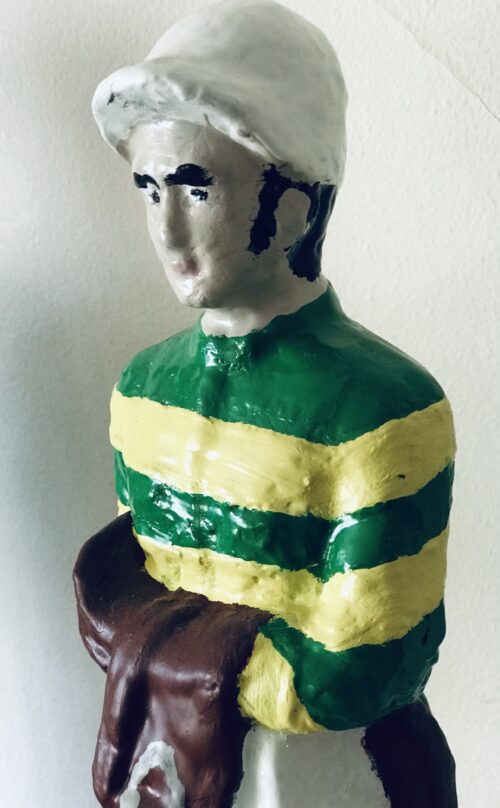
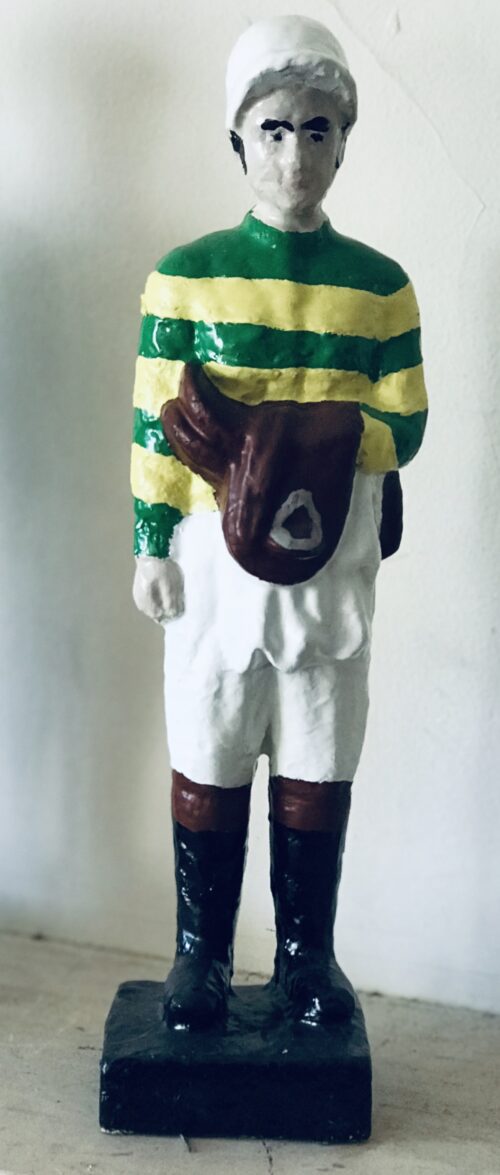 Unique and unusual cast-iron Jockey Figurine in the legendary JP McManus These charming little gentleman stands 38cm tall and is approx 10cm wide at his plinth.They weigh a surprising 6kg.These limited edition figurines were part of a collection which stood pride of place at a well known public house in Co Kerry.Also available in colours such as Rich Ricci,Gigginstown,Coolmore,Arkle,Frankel.These figurines will make a stunning addition to any home bar or pub. 38cm x 10cm 6kg
Unique and unusual cast-iron Jockey Figurine in the legendary JP McManus These charming little gentleman stands 38cm tall and is approx 10cm wide at his plinth.They weigh a surprising 6kg.These limited edition figurines were part of a collection which stood pride of place at a well known public house in Co Kerry.Also available in colours such as Rich Ricci,Gigginstown,Coolmore,Arkle,Frankel.These figurines will make a stunning addition to any home bar or pub. 38cm x 10cm 6kg -

 Superb vintage WW1 recruitment poster imploring the young men of Ireland to join the British Army.The poster depicts a lone piper with the famous mascot of the Royal Irish Regiment ,an Irish Wolfhound. 47cm x 38cm Nenagh Co TipperaryThe British Army was a volunteer force when war broke out in 1914, and within weeks thousands of Irishmen had signed up to serve 'King and Country'. Ireland had a strong military tradition in the British armed forces, dating back to at least the early 1500s, and when war was declared on August 4, 1914, there were some 20,000 Irishmen already serving from a total army strength of some 247,000. In addition, there were another 30,000 in the first-line reserve, from a total of 145,000. But more were quickly needed. Secretary for War Lord Kitchener told the British cabinet that it would be a three-year conflict requiring at least one million men, meaning a recruitment drive was immediately undertaken. Posters quickly appeared across the country, focused on attracting men from all background Some appealed to a sense of duty and honour, but appeared to be aimed at British-born nationals rather than Irishmen.
Superb vintage WW1 recruitment poster imploring the young men of Ireland to join the British Army.The poster depicts a lone piper with the famous mascot of the Royal Irish Regiment ,an Irish Wolfhound. 47cm x 38cm Nenagh Co TipperaryThe British Army was a volunteer force when war broke out in 1914, and within weeks thousands of Irishmen had signed up to serve 'King and Country'. Ireland had a strong military tradition in the British armed forces, dating back to at least the early 1500s, and when war was declared on August 4, 1914, there were some 20,000 Irishmen already serving from a total army strength of some 247,000. In addition, there were another 30,000 in the first-line reserve, from a total of 145,000. But more were quickly needed. Secretary for War Lord Kitchener told the British cabinet that it would be a three-year conflict requiring at least one million men, meaning a recruitment drive was immediately undertaken. Posters quickly appeared across the country, focused on attracting men from all background Some appealed to a sense of duty and honour, but appeared to be aimed at British-born nationals rather than Irishmen. -

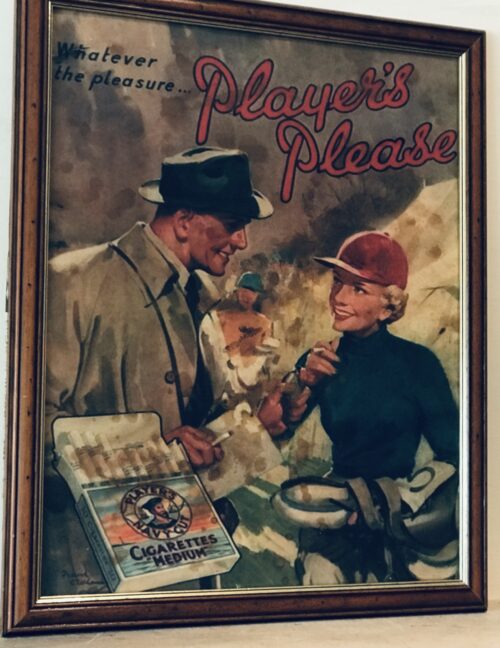 Original,Interesting and rather furtive Players Please Navy Cut Cigarette Show Card Advert. 57cm x 47cm Newbridge Co Kildare Navy cut were a brand of cigarettes manufactured by Imperial Brands –formerly John Player & Sons– in Nottingham, England.The brand became "Player's Navy Cut". They were particularly popular in Britain,Ireland and Germany in the late 19th century and early part of the 20th century, but were later produced in the United States. The packet has the distinctive logo of a smoking sailor in a 'Navy Cut' cap. The phrase "Navy Cut" is according to Player's adverts to originate from the habit of sailors taking a mixture of tobacco leaves and binding them with string or twine. The tobacco would then mature under pressure and the sailor could then dispense the tobacco by slicing off a "cut".The product is also available in pipe tobacco form. The cigarettes were available in tins and the original cardboard container was a four sided tray of cigarettes that slid out from a covering like a classic matchbox. The next design had fold in ends so that the cigarettes could be seen or dispensed without sliding out the tray. In the 1950s the packaging moved to the flip top design like most brands. The image of the sailor was known as "Hero" because of the name on his hat band. It was first used in 1883 and the lifebuoy was added five years later. The sailor images were an 1891 artists concept registered for Chester-based William Parkins and Co for their "Jack Glory" brand.Behind the sailor are two ships. The one on the left is thought to be HMS Britannia and the one on the right HMS Dreadnought or HMS Hero. As time went by the image of the sailor changed as it sometimes had a beard and other times he was clean shaven. In 1927 "Hero" was standardised on a 1905 version. As part of the 1927 marketing campaign John Player and Sons commissioned an oil painting Head of a Sailor by Arthur David McCormick.The Player's Hero logo was thought to contribute to the cigarettes popularity in the 20s and 30s when competitor W.D. & H.O. Wills tried to create a similar image. Unlike Craven A, Navy Cut was intended to have a unisex appeal. Advertisements referred to "the appeal to Eve's fair daughters" and lines like "Men may come and Men may go".Hero is thought to have originally meant to indicate traditional British values, but his masculinity appealed directly to men and as a potential uncle figure for younger women. One slogan written inside the packet was "It's the tobacco that counts" and another was "Player's Please" which was said to appeal to the perceived desire of the population to be included in the mass market. The slogan was so well known that it was sufficient in a shop to get a packet of this brand. Player's Medium Navy Cut was the most popular by far of the three Navy Cut brands (there was also Mild and Gold Leaf). Two thirds of all the cigarettes sold in Britain were Players and two thirds of these was branded as Players Medium Navy Cut. In January 1937, Players sold nearly 3.5 million cigarettes (which included 1.34 million in London. The popularity of the brand was mostly amongst the middle class and in the South of England. While it was smoked in the north, other brands were locally more popular. The brand was discontinued in the UK in 2016.WWII cigarette packets exhibited at Monmouth Regimental Museumin 2012
Original,Interesting and rather furtive Players Please Navy Cut Cigarette Show Card Advert. 57cm x 47cm Newbridge Co Kildare Navy cut were a brand of cigarettes manufactured by Imperial Brands –formerly John Player & Sons– in Nottingham, England.The brand became "Player's Navy Cut". They were particularly popular in Britain,Ireland and Germany in the late 19th century and early part of the 20th century, but were later produced in the United States. The packet has the distinctive logo of a smoking sailor in a 'Navy Cut' cap. The phrase "Navy Cut" is according to Player's adverts to originate from the habit of sailors taking a mixture of tobacco leaves and binding them with string or twine. The tobacco would then mature under pressure and the sailor could then dispense the tobacco by slicing off a "cut".The product is also available in pipe tobacco form. The cigarettes were available in tins and the original cardboard container was a four sided tray of cigarettes that slid out from a covering like a classic matchbox. The next design had fold in ends so that the cigarettes could be seen or dispensed without sliding out the tray. In the 1950s the packaging moved to the flip top design like most brands. The image of the sailor was known as "Hero" because of the name on his hat band. It was first used in 1883 and the lifebuoy was added five years later. The sailor images were an 1891 artists concept registered for Chester-based William Parkins and Co for their "Jack Glory" brand.Behind the sailor are two ships. The one on the left is thought to be HMS Britannia and the one on the right HMS Dreadnought or HMS Hero. As time went by the image of the sailor changed as it sometimes had a beard and other times he was clean shaven. In 1927 "Hero" was standardised on a 1905 version. As part of the 1927 marketing campaign John Player and Sons commissioned an oil painting Head of a Sailor by Arthur David McCormick.The Player's Hero logo was thought to contribute to the cigarettes popularity in the 20s and 30s when competitor W.D. & H.O. Wills tried to create a similar image. Unlike Craven A, Navy Cut was intended to have a unisex appeal. Advertisements referred to "the appeal to Eve's fair daughters" and lines like "Men may come and Men may go".Hero is thought to have originally meant to indicate traditional British values, but his masculinity appealed directly to men and as a potential uncle figure for younger women. One slogan written inside the packet was "It's the tobacco that counts" and another was "Player's Please" which was said to appeal to the perceived desire of the population to be included in the mass market. The slogan was so well known that it was sufficient in a shop to get a packet of this brand. Player's Medium Navy Cut was the most popular by far of the three Navy Cut brands (there was also Mild and Gold Leaf). Two thirds of all the cigarettes sold in Britain were Players and two thirds of these was branded as Players Medium Navy Cut. In January 1937, Players sold nearly 3.5 million cigarettes (which included 1.34 million in London. The popularity of the brand was mostly amongst the middle class and in the South of England. While it was smoked in the north, other brands were locally more popular. The brand was discontinued in the UK in 2016.WWII cigarette packets exhibited at Monmouth Regimental Museumin 2012 -

 67cm x 52cm Dunville & Co Whisky Distillery was founded in Belfast Co Antrim in the 1820s,after initially gaining success as a whisky blender before constructing its own distillery.In 1837 Dunville began producing its most popular whiskey,Dunvilles VR.Athough Dunvilles was established and based in Ireland before partition and Irish Whiskey is normally spellt with an 'e',Dunvilles Whisky was always spelt without the vowel.
67cm x 52cm Dunville & Co Whisky Distillery was founded in Belfast Co Antrim in the 1820s,after initially gaining success as a whisky blender before constructing its own distillery.In 1837 Dunville began producing its most popular whiskey,Dunvilles VR.Athough Dunvilles was established and based in Ireland before partition and Irish Whiskey is normally spellt with an 'e',Dunvilles Whisky was always spelt without the vowel. -

 Wooden Jameson Irish Whiskey Show Card pointing the way of the Beer Garden & toilets of a once famous pub in the west of Ireland. 70cm x 45cm. Achill Island Co Mayo John Jameson was originally a lawyer from Alloa in Scotland before he founded his eponymous distillery in Dublin in 1780.Prevoius to this he had made the wise move of marrying Margaret Haig (1753–1815) in 1768,one of the simple reasons being Margaret was the eldest daughter of John Haig, the famous whisky distiller in Scotland. John and Margaret had eight sons and eight daughters, a family of 16 children. Portraits of the couple by Sir Henry Raeburn are on display in the National Gallery of Ireland. John Jameson joined the Convivial Lodge No. 202, of the Dublin Freemasons on the 24th June 1774 and in 1780, Irish whiskey distillation began at Bow Street. In 1805, he was joined by his son John Jameson II who took over the family business that year and for the next 41 years, John Jameson II built up the business before handing over to his son John Jameson the 3rd in 1851. In 1901, the Company was formally incorporated as John Jameson and Son Ltd. Four of John Jameson’s sons followed his footsteps in distilling in Ireland, John Jameson II (1773 – 1851) at Bow Street, William and James Jameson at Marrowbone Lane in Dublin (where they partnered their Stein relations, calling their business Jameson and Stein, before settling on William Jameson & Co.). The fourth of Jameson's sons, Andrew, who had a small distillery at Enniscorthy, Co. Wexford, was the grandfather of Guglielmo Marconi, inventor of wireless telegraphy. Marconi’s mother was Annie Jameson, Andrew’s daughter. John Jameson’s eldest son, Robert took over his father’s legal business in Alloa. The Jamesons became the most important distilling family in Ireland, despite rivalry between the Bow Street and Marrowbone Lane distilleries. By the turn of the 19th century, it was the second largest producer in Ireland and one of the largest in the world, producing 1,000,000 gallons annually. Dublin at the time was the centre of world whiskey production. It was the second most popular spirit in the world after rum and internationally Jameson had by 1805 become the world's number one whiskey. Today, Jameson is the world's third largest single-distillery whiskey. Historical events, for a time, set the company back. The temperance movement in Ireland had an enormous impact domestically but the two key events that affected Jameson were the Irish War of Independence and subsequent trade war with the British which denied Jameson the export markets of the Commonwealth, and shortly thereafter, the introduction of prohibition in the United States. While Scottish brands could easily slip across the Canada–US border, Jameson was excluded from its biggest market for many years. The introduction of column stills by the Scottish blenders in the mid-19th-century enabled increased production that the Irish, still making labour-intensive single pot still whiskey, could not compete with. There was a legal enquiry somewhere in 1908 to deal with the trade definition of whiskey. The Scottish producers won within some jurisdictions, and blends became recognised in the law of that jurisdiction as whiskey. The Irish in general, and Jameson in particular, continued with the traditional pot still production process for many years.In 1966 John Jameson merged with Cork Distillers and John Powers to form the Irish Distillers Group. In 1976, the Dublin whiskey distilleries of Jameson in Bow Street and in John's Lane were closed following the opening of a New Midleton Distillery by Irish Distillers outside Cork. The Midleton Distillery now produces much of the Irish whiskey sold in Ireland under the Jameson, Midleton, Powers, Redbreast, Spot and Paddy labels. The new facility adjoins the Old Midleton Distillery, the original home of the Paddy label, which is now home to the Jameson Experience Visitor Centre and the Irish Whiskey Academy. The Jameson brand was acquired by the French drinks conglomerate Pernod Ricard in 1988, when it bought Irish Distillers. The old Jameson Distillery in Bow Street near Smithfield in Dublin now serves as a museum which offers tours and tastings. The distillery, which is historical in nature and no longer produces whiskey on site, went through a $12.6 million renovation that was concluded in March 2016, and is now a focal part of Ireland's strategy to raise the number of whiskey tourists, which stood at 600,000 in 2017.Bow Street also now has a fully functioning Maturation Warehouse within its walls since the 2016 renovation. It is here that Jameson 18 Bow Street is finished before being bottled at Cask Strength. In 2008, The Local, an Irish pub in Minneapolis, sold 671 cases of Jameson (22 bottles a day),making it the largest server of Jameson's in the world – a title it maintained for four consecutive years.
Wooden Jameson Irish Whiskey Show Card pointing the way of the Beer Garden & toilets of a once famous pub in the west of Ireland. 70cm x 45cm. Achill Island Co Mayo John Jameson was originally a lawyer from Alloa in Scotland before he founded his eponymous distillery in Dublin in 1780.Prevoius to this he had made the wise move of marrying Margaret Haig (1753–1815) in 1768,one of the simple reasons being Margaret was the eldest daughter of John Haig, the famous whisky distiller in Scotland. John and Margaret had eight sons and eight daughters, a family of 16 children. Portraits of the couple by Sir Henry Raeburn are on display in the National Gallery of Ireland. John Jameson joined the Convivial Lodge No. 202, of the Dublin Freemasons on the 24th June 1774 and in 1780, Irish whiskey distillation began at Bow Street. In 1805, he was joined by his son John Jameson II who took over the family business that year and for the next 41 years, John Jameson II built up the business before handing over to his son John Jameson the 3rd in 1851. In 1901, the Company was formally incorporated as John Jameson and Son Ltd. Four of John Jameson’s sons followed his footsteps in distilling in Ireland, John Jameson II (1773 – 1851) at Bow Street, William and James Jameson at Marrowbone Lane in Dublin (where they partnered their Stein relations, calling their business Jameson and Stein, before settling on William Jameson & Co.). The fourth of Jameson's sons, Andrew, who had a small distillery at Enniscorthy, Co. Wexford, was the grandfather of Guglielmo Marconi, inventor of wireless telegraphy. Marconi’s mother was Annie Jameson, Andrew’s daughter. John Jameson’s eldest son, Robert took over his father’s legal business in Alloa. The Jamesons became the most important distilling family in Ireland, despite rivalry between the Bow Street and Marrowbone Lane distilleries. By the turn of the 19th century, it was the second largest producer in Ireland and one of the largest in the world, producing 1,000,000 gallons annually. Dublin at the time was the centre of world whiskey production. It was the second most popular spirit in the world after rum and internationally Jameson had by 1805 become the world's number one whiskey. Today, Jameson is the world's third largest single-distillery whiskey. Historical events, for a time, set the company back. The temperance movement in Ireland had an enormous impact domestically but the two key events that affected Jameson were the Irish War of Independence and subsequent trade war with the British which denied Jameson the export markets of the Commonwealth, and shortly thereafter, the introduction of prohibition in the United States. While Scottish brands could easily slip across the Canada–US border, Jameson was excluded from its biggest market for many years. The introduction of column stills by the Scottish blenders in the mid-19th-century enabled increased production that the Irish, still making labour-intensive single pot still whiskey, could not compete with. There was a legal enquiry somewhere in 1908 to deal with the trade definition of whiskey. The Scottish producers won within some jurisdictions, and blends became recognised in the law of that jurisdiction as whiskey. The Irish in general, and Jameson in particular, continued with the traditional pot still production process for many years.In 1966 John Jameson merged with Cork Distillers and John Powers to form the Irish Distillers Group. In 1976, the Dublin whiskey distilleries of Jameson in Bow Street and in John's Lane were closed following the opening of a New Midleton Distillery by Irish Distillers outside Cork. The Midleton Distillery now produces much of the Irish whiskey sold in Ireland under the Jameson, Midleton, Powers, Redbreast, Spot and Paddy labels. The new facility adjoins the Old Midleton Distillery, the original home of the Paddy label, which is now home to the Jameson Experience Visitor Centre and the Irish Whiskey Academy. The Jameson brand was acquired by the French drinks conglomerate Pernod Ricard in 1988, when it bought Irish Distillers. The old Jameson Distillery in Bow Street near Smithfield in Dublin now serves as a museum which offers tours and tastings. The distillery, which is historical in nature and no longer produces whiskey on site, went through a $12.6 million renovation that was concluded in March 2016, and is now a focal part of Ireland's strategy to raise the number of whiskey tourists, which stood at 600,000 in 2017.Bow Street also now has a fully functioning Maturation Warehouse within its walls since the 2016 renovation. It is here that Jameson 18 Bow Street is finished before being bottled at Cask Strength. In 2008, The Local, an Irish pub in Minneapolis, sold 671 cases of Jameson (22 bottles a day),making it the largest server of Jameson's in the world – a title it maintained for four consecutive years. -

 Team photograph of the Irish Rugby Team that played Wales in the first ever Rugby International ever held in Limerick in the County Cricket Grounds (now the Limerick Lawn Tennis Club) Ennis Road on the 19th March 1898. 42cm x 30cm Parnell St Limerick City
Team photograph of the Irish Rugby Team that played Wales in the first ever Rugby International ever held in Limerick in the County Cricket Grounds (now the Limerick Lawn Tennis Club) Ennis Road on the 19th March 1898. 42cm x 30cm Parnell St Limerick City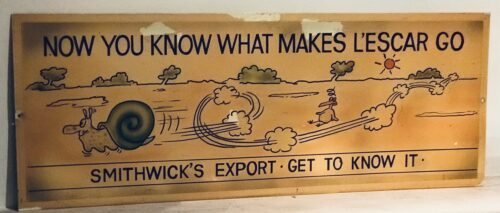
 44cm x 22cm Dublin Nice 1990s retro Smithwicks clock The old Smithwicks brewery is on the site of a Franciscan abbey, where monks had brewed ale since the 14th century, and ruins of the original abbey still remain on its grounds. The old brewery has since been renovated and now hosts "The Smithwick's Experience Kilkenny" visitor attraction and centre.At the time of its closure, it was Ireland's oldest operating brewery. John Smithwick was an orphan who had settled in Kilkenny. Shortly after his arrival, Smithwick went into the brewing business with Richard Cole on a piece of land that Cole had leased from the Duke of Ormond in 1705. Five years later, John Smithwick became the owner of the land. The brewery stayed small, servicing a loyal local following while John Smithwick diversified. Following John Smithwick's death, the brewery temporarily fell out of family hands. John Smithwick's great grandson, Edmond bought the brewery land back freehold and worked to reshape its future. Edmond concentrated on discovering new markets and successfully building export trade. Drinkers in England, Scotland and Wales developed a taste for Smithwick's brews and output increased fivefold. As a result of substantial contributions made to St Mary's Cathedral, Edmond became great friends with Irish liberal Daniel O'Connell, who later became godfather to one of his sons. Edmond Smithwick became well known and respected by the people of Kilkenny who elected him town mayor four times. In 1800, export sales began to fall and the brewing industry encountered difficulty. To combat this, the Smithwick family increased production in their maltings, began selling mineral water and delivered butter with the ale from the back of their drays.By 1900, output was at an all-time low and the then owner James Smithwick was advised by auditors to shut the doors of the brewery. Instead, James reduced the range of beers they produced and set out to find new markets. He secured military contracts and soon after saw output increase again. James' son, Walter, took control in 1930 and steered the brewery to success through the hardships of both World War II and increasingly challenging weather conditions.By January 1950, Smithwick's was exporting ale to Boston.Smithwick's was purchased from Walter Smithwick in 1965 by Guinness and is now, along with Guinness, part of Diageo. Together, Guinness & Co. and Smithwick's developed and launched Smithwick's Draught Ale in 1966. By 1979, half a million barrels were sold each year.In 1980, Smithwick's began exporting to France. In 1993, Smithwick's Draught became Canada's leading imported ale.By 2010, Smithwick's continued to be brewed in Dundalk and Kilkenny with tankers sent to Dublin to be kegged for the on trade market. Cans and bottles were packaged by IBC in Belfast.Production in the Kilkenny brewery finished on 31 December 2013 and Smithwicks brands are now produced in the Diageo St.James' Gate brewery in Dublin.The original Kilkenny site was sold to Kilkenny County Council, with a small portion of the site dedicated to the opening of a visitor's centre, the "Smithwick's Experience Kilkenny".
44cm x 22cm Dublin Nice 1990s retro Smithwicks clock The old Smithwicks brewery is on the site of a Franciscan abbey, where monks had brewed ale since the 14th century, and ruins of the original abbey still remain on its grounds. The old brewery has since been renovated and now hosts "The Smithwick's Experience Kilkenny" visitor attraction and centre.At the time of its closure, it was Ireland's oldest operating brewery. John Smithwick was an orphan who had settled in Kilkenny. Shortly after his arrival, Smithwick went into the brewing business with Richard Cole on a piece of land that Cole had leased from the Duke of Ormond in 1705. Five years later, John Smithwick became the owner of the land. The brewery stayed small, servicing a loyal local following while John Smithwick diversified. Following John Smithwick's death, the brewery temporarily fell out of family hands. John Smithwick's great grandson, Edmond bought the brewery land back freehold and worked to reshape its future. Edmond concentrated on discovering new markets and successfully building export trade. Drinkers in England, Scotland and Wales developed a taste for Smithwick's brews and output increased fivefold. As a result of substantial contributions made to St Mary's Cathedral, Edmond became great friends with Irish liberal Daniel O'Connell, who later became godfather to one of his sons. Edmond Smithwick became well known and respected by the people of Kilkenny who elected him town mayor four times. In 1800, export sales began to fall and the brewing industry encountered difficulty. To combat this, the Smithwick family increased production in their maltings, began selling mineral water and delivered butter with the ale from the back of their drays.By 1900, output was at an all-time low and the then owner James Smithwick was advised by auditors to shut the doors of the brewery. Instead, James reduced the range of beers they produced and set out to find new markets. He secured military contracts and soon after saw output increase again. James' son, Walter, took control in 1930 and steered the brewery to success through the hardships of both World War II and increasingly challenging weather conditions.By January 1950, Smithwick's was exporting ale to Boston.Smithwick's was purchased from Walter Smithwick in 1965 by Guinness and is now, along with Guinness, part of Diageo. Together, Guinness & Co. and Smithwick's developed and launched Smithwick's Draught Ale in 1966. By 1979, half a million barrels were sold each year.In 1980, Smithwick's began exporting to France. In 1993, Smithwick's Draught became Canada's leading imported ale.By 2010, Smithwick's continued to be brewed in Dundalk and Kilkenny with tankers sent to Dublin to be kegged for the on trade market. Cans and bottles were packaged by IBC in Belfast.Production in the Kilkenny brewery finished on 31 December 2013 and Smithwicks brands are now produced in the Diageo St.James' Gate brewery in Dublin.The original Kilkenny site was sold to Kilkenny County Council, with a small portion of the site dedicated to the opening of a visitor's centre, the "Smithwick's Experience Kilkenny".
 38cm x 8cm Limerick City
38cm x 8cm Limerick CityThe former beer of choice of An Taoiseach Bertie Ahern,the Bass Ireland Brewery operated on the Glen Road in West Belfast for 107 years until its closure in 2004.But despite its popularity, this ale would be the cause of bitter controversy in the 1930s as you can learn below.
Founded in 1777 by William Bass in Burton-upon-Trent, Staffordshire, England.The main brand was Bass Pale Ale, once the highest-selling beer in the UK.By 1877, Bass had become the largest brewery in the world, with an annual output of one million barrels.Its pale ale was exported throughout the British Empire, and the company's distinctive red triangle became the UK's first registered trade mark. In the early 1930s republicans in Dublin and elsewhere waged a campaign of intimidation against publicans who sold Bass ale, which involved violent tactics and grabbed headlines at home and further afield. This campaign occurred within a broader movement calling for the boycott of British goods in Ireland, spearheaded by the IRA. Bass was not alone a British product, but republicans took issue with Colonel John Gretton, who was chairman of the company and a Conservative politician in his day.In Britain,Ireland and the Second World War, Ian Woods notes that the republican newspaper An Phoblacht set the republican boycott of Bass in a broader context , noting that there should be “No British ales. No British sweets or chocolate. Shoulder to shoulder for a nationwide boycott of British goods. Fling back the challenge of the robber empire.”
In late 1932, Irish newspapers began to report on a sustained campaign against Bass ale, which was not strictly confined to Dublin. On December 5th 1932, The Irish Times asked:
Will there be free beer in the Irish Free State at the end of this week? The question is prompted by the orders that are said to have been given to publicans in Dublin towards the end of last week not to sell Bass after a specified date.
The paper went on to claim that men visited Dublin pubs and told publicans “to remove display cards advertising Bass, to dispose of their stock within a week, and not to order any more of this ale, explaining that their instructions were given in furtherance of the campaign to boycott British goods.” The paper proclaimed a ‘War on English Beer’ in its headline. The same routine, of men visiting and threatening public houses, was reported to have happened in Cork.
It was later reported that on November 25th young men had broken into the stores owned by Bass at Moore Lane and attempted to do damage to Bass property. When put before the courts, it was reported that the republicans claimed that “Colonel Gretton, the chairman of the company, was a bitter enemy of the Irish people” and that he “availed himself of every opportunity to vent his hate, and was an ardent supporter of the campaign of murder and pillage pursued by the Black and Tans.” Remarkably, there were cheers in court as the men were found not guilty, and it was noted that they had no intention of stealing from Bass, and the damage done to the premises amounted to less than £5.
A campaign of intimidation carried into January 1933, when pubs who were not following the boycott had their signs tarred, and several glass signs advertising the ale were smashed across the city. ‘BOYCOTT BRITISH GOODS’ was painted across several Bass advertisements in the city.
Throughout 1933, there were numerous examples of republicans entering pubs and smashing the supply of Bass bottles behind the counter. This activity was not confined to Dublin,as this report from late August shows. It was noted that the men publicly stated that they belonged to the IRA.
September appears to have been a particularly active period in the boycott, with Brian Hanley identifying Dublin, Tralee, Naas, Drogheda and Waterford among the places were publicans were targetted in his study The IRA: 1926-1936. One of the most interesting incidents occurring in Dun Laoghaire. There, newspapers reported that on September 4th 1933 “more than fifty young men marched through the streets” before raiding the premises of Michael Moynihan, a local publican. Bottles of Bass were flung onto the roadway and advertisements destroyed. Five young men were apprehended for their role in the disturbances, and a series of court cases nationwide would insure that the Bass boycott was one of the big stories of September 1933.
The young men arrested in Dun Laoghaire refused to give their name or any information to the police, and on September 8th events at the Dublin District Court led to police baton charging crowds. The Irish Times reported that about fifty supporters of the young men gathered outside the court with placards such as ‘Irish Goods for Irish People’, and inside the court a cry of ‘Up The Republic!’ led to the judge slamming the young men, who told him they did not recognise his court. The night before had seen some anti-Bass activity in the city, with the smashing of Bass signs at Burgh Quay. This came after attacks on pubs at Lincoln Place and Chancery Street. It wasn’t long before Mountjoy and other prisons began to home some of those involved in the Boycott Bass campaign, which the state was by now eager to suppress.

An undated image of a demonstration to boycott British goods. Credit: http://irishmemory.blogspot.ie/
This dramatic court appearance was followed by similar scenes in Kilmainham, where twelve men were brought before the courts for a raid on the Dead Man’s Pub, near to Palmerstown in West Dublin. Almost all in their 20s, these men mostly gave addresses in Clondalkin. Their court case was interesting as charges of kidnapping were put forward, as Michael Murray claimed the men had driven him to the Featherbed mountain. By this stage, other Bass prisoners had begun a hungerstrike, and while a lack of evidence allowed the men to go free, heavy fines were handed out to an individual who the judge was certain had been involved.
The decision to go on hungerstrike brought considerable attention on prisoners in Mountjoy, and Maud Gonne MacBride spoke to the media on their behalf, telling the Irish Press on September 18th that political treatment was sought by the men. This strike had begun over a week previously on the 10th, and by the 18th it was understood that nine young men were involved. Yet by late September, it was evident the campaign was slowing down, particularly in Dublin.
The controversy around the boycott Bass campaign featured in Dáil debates on several occasions. In late September Eamonn O’Neill T.D noted that he believed such attacks were being allowed to be carried out “with a certain sort of connivance from the Government opposite”, saying:
I suppose the Minister is aware that this campaign against Bass, the destruction of full bottles of Bass, the destruction of Bass signs and the disfigurement of premises which Messrs. Bass hold has been proclaimed by certain bodies to be a national campaign in furtherance of the “Boycott British Goods” policy. I put it to the Minister that the compensation charges in respect of such claims should be made a national charge as it is proclaimed to be a national campaign and should not be placed on the overburdened taxpayers in the towns in which these terrible outrages are allowed to take place with a certain sort of connivance from the Government opposite.
Another contribution in the Dáil worth quoting came from Daniel Morrissey T.D, perhaps a Smithwicks man, who felt it necessary to say that we were producing “an ale that can compare favourably with any ale produced elsewhere” while condemning the actions of those targeting publicans:
I want to say that so far as I am concerned I have no brief good, bad, or indifferent, for Bass’s ale. We are producing in this country at the moment—and I am stating this quite frankly as one who has a little experience of it—an ale that can compare favourably with any ale produced elsewhere. But let us be quite clear that if we are going to have tariffs or embargoes, no tariffs or embargoes can be issued or given effect to in this country by any person, any group of persons, or any organisation other than the Government elected by the people of the country.
Tim Pat Coogan claims in his history of the IRA that this boycott brought the republican movement into conflict with the Army Comrades Association, later popularly known as the ‘Blueshirts’. He claims that following attacks in Dublin in December 1932, “the Dublin vitners appealed to the ACA for protection and shipments of Bass were guarded by bodyguards of ACA without further incident.” Yet it is undeniable there were many incidents of intimidation against suppliers and deliverers of the product into 1933.
Not all republicans believed the ‘Boycott Bass’ campaign had been worthwhile. Patrick Byrne, who would later become secretary within the Republican Congress group, later wrote that this was a time when there were seemingly bigger issues, like mass unemployment and labour disputes in Belfast, yet:
In this situation, while the revolution was being served up on a plate in Belfast, what was the IRA leadership doing? Organising a ‘Boycott Bass’ Campaign. Because of some disparaging remarks the Bass boss, Colonel Gretton, was reported to have made about the Irish, some IRA leaders took umbrage and sent units out onto the streets of Dublin and elsewhere to raid pubs, terrify the customers, and destroy perfectly good stocks of bottled Bass, an activity in which I regret to say I was engaged.
Historian Brian Hanley has noted by late 1933 “there was little effort to boycott anything except Bass and the desperation of the IRA in hoping violence would revive the campaign was in fact an admission of its failure. At the 1934 convention the campaign was quietly abandoned.”
Interestingly, this wasn’t the last time republicans would threaten Bass. In 1986 The Irish Times reported that Bass and Guinness were both threatened on the basis that they were supplying to British Army bases and RUC stations, on the basis of providing a service to security forces.
Origins : Co Galway
Dimensions:35 cm x 45cm





